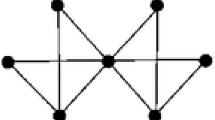Abstract
Eternal domination is a dynamic process by which a graph is protected from an infinite sequence of vertex intrusions. In eternal distance-k domination, guards initially occupy the vertices of a distance-k dominating set. After a vertex is attacked, guards “defend” by each moving up to distance k to form a distance-k dominating set, such that some guard occupies the attacked vertex. The eternal distance-k domination number of a graph is the minimum number of guards needed to defend against any sequence of attacks. The process is well-studied for the situation where \(k=1\). We introduce eternal distance-k domination for \(k > 1\). Determining whether a given set is an eternal distance-k domination set is in EXP, and in this paper we provide a number of results for paths and cycles, and relate this parameter to graph powers and domination in general. For trees we use decomposition arguments to bound the eternal distance-k domination numbers, and solve the problem entirely in the case of perfect m-ary trees.







Similar content being viewed by others
References
Blažej, V., Křišt’an, J.M., Valla, T.: On the m-eternal domination number of cactus graphs. In: Filiot, E., Jungers, R., Potapov, I. (eds.) Reachability Problems. RP 2019. Lecture Notes in Computer Science, vol. 11674. Springer, Cham (2019)
Cohen, N., Martins, N.A., Mc Inerney, F., Nisse, N., Pérennes, S., Sampaio, R.: Spy-game on graphs: complexity and simple topologies. Theor. Comput. Sci. 725, 1–15 (2018)
Finbow, S., Gaspers, S., Messinger, M.E., Ottoway, P.: A note on the eternal dominating set problem. Int. J. Game Theory 47, 543–555 (2018)
Finbow, S., Messinger, M.E., van Bommel, M.F.: Eternal domination on \(3 \times n\) grids. Australas. J. Comb. 61(2), 156–174 (2015)
Gagnon, A., Hassler, A., Huang, J., Krim-Yee, A., Mc Inerney, F., Zacarias, A., Seamone, B., Virgile, V.: A method for eternally dominating strong grids. Discrete Math. Theor. Comput. Sci. 22(1), 1–11 (2020)
Henning, M., Klostermeyer, W.F., MacGillivray, G.: Bounds for the \(m\)-eternal domination number of a graph. Contrib. Discrete Math. 12(2), 91–103 (2017)
Klostermeyer, W.F.: Complexity of eternal security. J. Comb. Math. Comb. Comput. 61, 135–141 (2007)
Klostermeyer, W. F.: Errata. https://www.unf.edu/~wkloster/errata.html
Klostermeyer, W.F., MacGillivray, G.: Eternal dominating sets in graphs. J. Comb. Math. Comb. Comput. 68, 97–111 (2009)
Klostermeyer, W.F., Mynhardt, C.M.: Protecting a graph with mobile guards. Appl. Anal. Discrete Math. 10, 1–29 (2016)
Lamprou, I., Martin, R., Schewe, S.: Eternally dominating large grids. Theor. Comput. Sci. 794(19), 27–46 (2019)
Sridharan, N., Subramanian, V.S.A., Elias, M.E.: Bounds on the distance two-domination number of a graph. Graphs Comb. 18, 667–675 (2002)
van Bommel, C.M., van Bommel, M.F.: Eternal domination numbers of \(5 \times n\) grid graphs. J. Comb. Math. Comb. Comput. 97, 83–102 (2016)
Acknowledgements
M.E. Messinger acknowledges research support from NSERC (grant application 2018-04059). D. Cox acknowledges research support from NSERC (2017-04401) and Mount Saint Vincent University. E. Meger acknowledges research support from Université du Québec à Montréal and Mount Allison University.The authors also thank the reviewers for the detailed reviews and suggestions for notational changes that improved the readability and quality of the results.
Funding
M.E. Messinger acknowledges research support from NSERC (grant application 2018-04059). D. Cox acknowledges research support from NSERC (2017-04401) and Mount Saint Vincent University. E. Meger acknowledges research support from Université du Québec à Montréal and Mount Allison University.
Author information
Authors and Affiliations
Corresponding author
Ethics declarations
Conflicts of Interest
The authors have no conflicts of interest to declare that are relevant to the content of this article.
Additional information
Publisher's Note
Springer Nature remains neutral with regard to jurisdictional claims in published maps and institutional affiliations.
Rights and permissions
Springer Nature or its licensor (e.g. a society or other partner) holds exclusive rights to this article under a publishing agreement with the author(s) or other rightsholder(s); author self-archiving of the accepted manuscript version of this article is solely governed by the terms of such publishing agreement and applicable law.
About this article
Cite this article
Cox, D., Meger, E. & Messinger, M.E. Eternal Distance-k Domination on Graphs. La Matematica 2, 283–302 (2023). https://doi.org/10.1007/s44007-023-00044-3
Received:
Revised:
Accepted:
Published:
Issue Date:
DOI: https://doi.org/10.1007/s44007-023-00044-3




